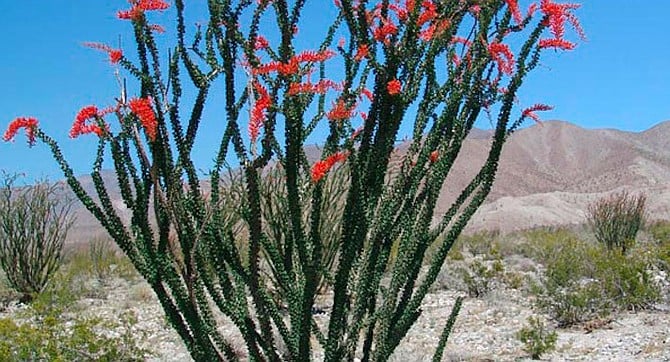 Facebook
Facebook
 X
X
 Instagram
Instagram
 TikTok
TikTok
 Youtube
Youtube

Thunderstorms have visited the Imperial Valley and parts of eastern San Diego County over the past several weeks. The seasonal arrival of moisture from the east and south, more or less typical for late summer, contributes to the greening of certain kinds of vegetation. On the desert floor, for example, the spidery ocotillo can grow an instant crop of green leaves after a storm, only to drop them two to three weeks later if no further rain arrives. The distribution of green-leaved ocotillos tells not only where rain has recently fallen; it also indicates where the runoff has collected and remained for enough time to be absorbed by the ocotillo’s root system.
Warm Water Temperatures, into the 70s Fahrenheit over the past several weeks, won’t last much longer. As fall approaches, shorter days and increasingly oblique solar radiation will mean that less and less energy will be supplied to the ocean waters offshore. These waters will soon be shedding more thermal energy than they receive, thereby keeping the coastal area comforably balmy for several weeks after the end of the summer-vacation season. Don’t give up on the beach after Labor Day, though — the water’s only a bit cooler, and the beaches are relatively uncrowded.
Way, way, way down low in the bright afterglow of sunset, Mercury and Mars are in conjunction only 0.1° apart (for North America). About 15 or 20 minutes after sunset, use binoculars or a small telescope to try to pick up Mercury a few degrees above the horizon. It’s a trace to the right of due west, far lower right of Venus. You’ve got a fairly good chance; Mercury is currently magnitude –0.5. Mars is another story; at magnitude +1.8 it’s only an eighth as bright. Good luck with that...
Venus, brilliant at magnitude –3.9, shines pure white in the west during twilight. It sets around twilight’s end.
Jupiter and Saturn shine in the southeast in late twilight and after dark. They’re magnitudes –2.9 and +0.2, respectively, in or very near Capricornus.
The above comes from the Outdoors listings in the Reader compiled by Jerry Schad, author of Afoot & Afield in San Diego County. Schad died in 2011. Planet information from SkyandTelescope.org.


Thunderstorms have visited the Imperial Valley and parts of eastern San Diego County over the past several weeks. The seasonal arrival of moisture from the east and south, more or less typical for late summer, contributes to the greening of certain kinds of vegetation. On the desert floor, for example, the spidery ocotillo can grow an instant crop of green leaves after a storm, only to drop them two to three weeks later if no further rain arrives. The distribution of green-leaved ocotillos tells not only where rain has recently fallen; it also indicates where the runoff has collected and remained for enough time to be absorbed by the ocotillo’s root system.
Warm Water Temperatures, into the 70s Fahrenheit over the past several weeks, won’t last much longer. As fall approaches, shorter days and increasingly oblique solar radiation will mean that less and less energy will be supplied to the ocean waters offshore. These waters will soon be shedding more thermal energy than they receive, thereby keeping the coastal area comforably balmy for several weeks after the end of the summer-vacation season. Don’t give up on the beach after Labor Day, though — the water’s only a bit cooler, and the beaches are relatively uncrowded.
Way, way, way down low in the bright afterglow of sunset, Mercury and Mars are in conjunction only 0.1° apart (for North America). About 15 or 20 minutes after sunset, use binoculars or a small telescope to try to pick up Mercury a few degrees above the horizon. It’s a trace to the right of due west, far lower right of Venus. You’ve got a fairly good chance; Mercury is currently magnitude –0.5. Mars is another story; at magnitude +1.8 it’s only an eighth as bright. Good luck with that...
Venus, brilliant at magnitude –3.9, shines pure white in the west during twilight. It sets around twilight’s end.
Jupiter and Saturn shine in the southeast in late twilight and after dark. They’re magnitudes –2.9 and +0.2, respectively, in or very near Capricornus.
The above comes from the Outdoors listings in the Reader compiled by Jerry Schad, author of Afoot & Afield in San Diego County. Schad died in 2011. Planet information from SkyandTelescope.org.
Comments